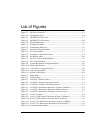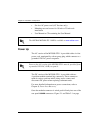
Chapter 1. Introduction
1-4 MX2800 STS-1 User Manual 61200659L1-1
compensation. Pointer adjustments allow the synchronous payload
envelope (SPE) to float with respect to the SONET frame. The
pointer is contained in the H1 and H2 bytes of the line overhead
(LOH), and is a count of the number of bytes the J1 byte is away
from the H3 byte, not including the transport overhead. When
timing differences exist, dummy bytes are inserted into the SPE
without affecting data. The receiving end can recover the payload
since the pointer is adjusted to indicate where the payload overhead
(POH) starts.
Transport Overhead (TOH)
The first three columns are the TOH, which contains the overhead
bytes for the Section and Line layers. Section overhead is
comprised of 9 bytes and Line overhead is comprised of 18 bytes.
STS-1 Synchronous Payload Envelope (SPE)
The SPE has 87 columns and 9 rows of bytes for a total of 783
bytes. Column 1 contains the STS Path Overhead and has 9 bytes.
The remaining 774 bytes are available for payload.
Virtual Tributaries (VT)
The SPE is divided into seven virtual tributary groups, made up of
12 columns each. Smaller tributaries are multiplexed together to
form these groups. For example, there can be four VT1.5 tributaries
in a VT group or three VT2 tributaries. A VT1.5 tributary consists
of three columns per STS-1 frame and has a bit rate of 1.728 Mbps,
allowing transport of a T1 at 1.544 Mbps plus required overhead. A
VT2 uses four columns per STS-1 frame and has a bit rate of 2.304
Mbps, allowing transport of an E1 at 2.048 Mbps plus required
overhead.


















